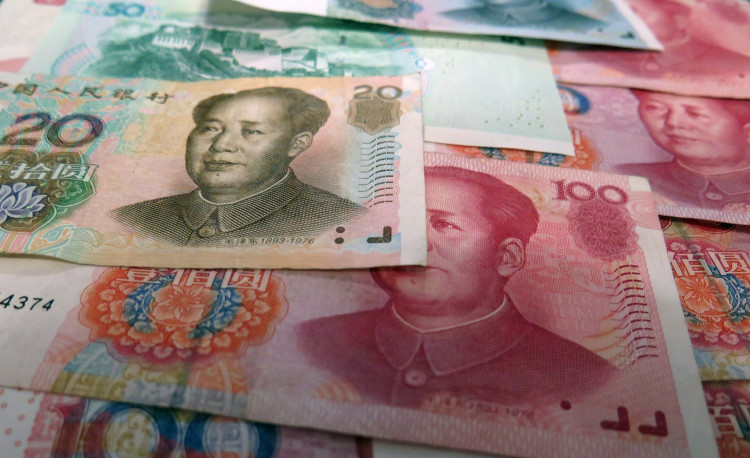China's central bank, the People's Bank of China (PBOC), took action on Monday to ease liquidity pressures by cutting the interest rate on its 14-day reverse repurchase (repo) agreements and injecting cash into the financial system. This move comes as China grapples with a broader economic slowdown and mounting deflationary pressures, signaling that the government is ready to further support its banking system. The PBOC's steps included injecting a total of 234.6 billion yuan (around $33.29 billion) into the market, split between 7-day and 14-day repos, with the latter being offered at a reduced rate for the first time in months.
The PBOC announced it would provide 160.1 billion yuan through 7-day reverse repos at an interest rate of 1.70%, the same as the rate established in July. More notably, it injected 74.5 billion yuan via 14-day reverse repos at 1.85%, a 10-basis-point decrease from the previous 1.95%. This cut aligns the 14-day rate with the previously lowered 7-day rate, raising speculation that broader easing measures could be forthcoming.
The timing of the PBOC's decision aligns with China's upcoming National Day holiday starting on October 1, a week-long break that traditionally prompts liquidity adjustments. In fact, the last time the PBOC provided 14-day repos was in February, just ahead of the Lunar New Year holiday. Analysts see the recent move as partly technical, aimed at maintaining sufficient liquidity in the banking system through the extended holiday period.
However, there's growing consensus that the cut is also indicative of larger plans to stimulate the economy. "I wouldn't take this rate cut as a signal that the PBOC loosened monetary policy further," said Zhang Zhiwei, chief economist at Pinpoint Asset Management. He added, "Nonetheless, I do expect the PBOC will cut the 7-day repo rate as well as the reserve requirement ratio in the coming months."
China's economy has been under strain, battling against deflationary pressures and struggling to meet growth expectations. Despite a series of policy measures aimed at stimulating domestic consumption, economic activity has remained sluggish, and recent data has shown disappointing outcomes. As a result, global brokerages have lowered their forecasts for China's growth in 2024 to below the government's official target of around 5%.
Experts are increasingly calling for more robust intervention. "A 10-basis-point cut alone is not sufficient to arrest the falling economic momentum," said Raymond Yeung, Chief Greater China Economist at ANZ. "A bigger package is needed. Other policy measures in the toolbox such as an RRR [reserve requirement ratio] cut, MLF [medium-term lending facility] cut, and mortgage rate cut will likely be announced."
Adding to the anticipation, the PBOC Governor, Pan Gongsheng, will be holding a rare joint press briefing on Tuesday alongside officials from the National Financial Regulatory Administration and China Securities Regulatory Commission. Market watchers expect further details on financial support measures that could be rolled out to spur growth.
China's monetary easing measures come amid similar global trends. The U.S. Federal Reserve, which initiated its easing cycle with a half-percentage point rate cut earlier, has increased speculation that China might follow suit more aggressively. The PBOC has already adjusted both short- and long-term lending rates, with the latest cut to the 14-day repo rate viewed as part of a broader shift to lower borrowing costs.
Zhang Zhiwei from Pinpoint Asset Management suggested that the PBOC's actions could be part of a more calculated approach, which might include cutting the reserve requirement ratio or the 7-day repo rate soon. "There is a press conference tomorrow when the financial regulators will shed light on their policy stance," Zhang said, adding that more easing is likely necessary to prevent a continued deceleration of the Chinese economy.
The global significance of China's economic slowdown cannot be understated. As the world's second-largest economy, the pace of China's growth-or lack thereof-has ramifications for international markets. A prolonged slowdown could affect everything from commodity prices to the profitability of multinational companies with heavy exposure to Chinese consumers.
Earlier this month, Chinese President Xi Jinping urged government officials to make all efforts necessary to achieve the country's annual economic and social development goals. However, the trajectory remains uncertain. With external pressures, such as a weak real estate market and lingering COVID-19 impacts, China's ability to rebound in the short term remains a key question for policymakers.
As the PBOC takes steps to ease financial conditions, analysts remain divided on whether the current measures are sufficient. Some see Monday's actions as a small but necessary step toward more significant intervention, while others argue that broader, more aggressive monetary policy is needed to stabilize the economy.
One potential area of further action is in the form of additional cuts to the reserve requirement ratio, a tool that banks use to determine how much capital must be held in reserve, freeing up more liquidity for lending. Some experts believe that China may also lower the medium-term lending facility rate or offer more targeted relief to specific sectors like real estate and manufacturing.
Markets have responded cautiously to the PBOC's latest moves. While there is optimism that the central bank is committed to providing liquidity support, concerns remain about whether these efforts will be enough to spur significant growth. Investors will be closely watching Tuesday's press conference for any additional signals regarding the future of China's monetary policy.






